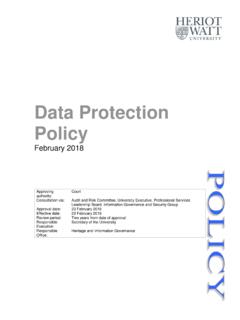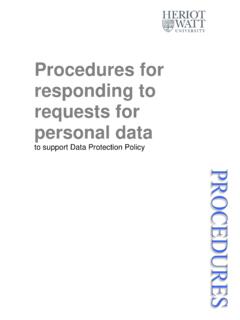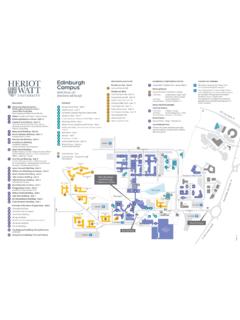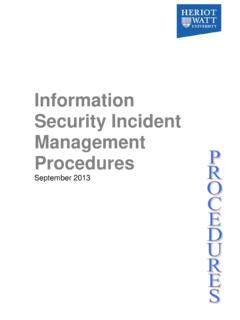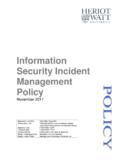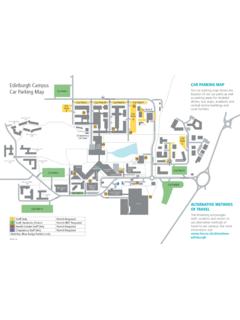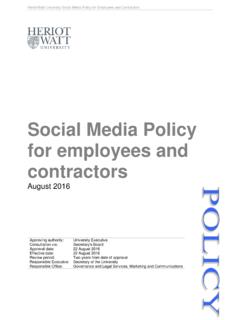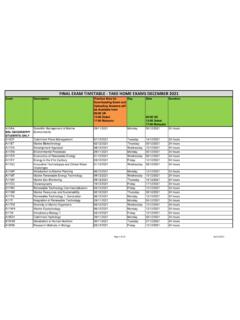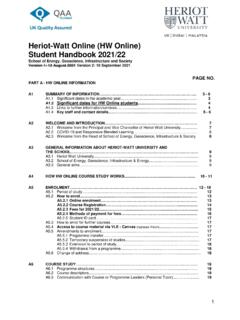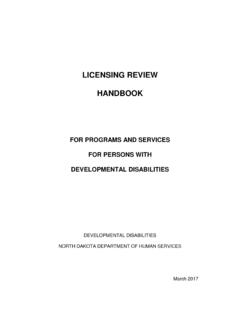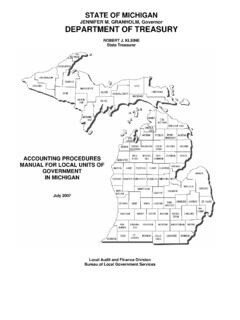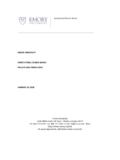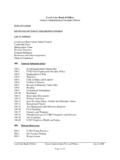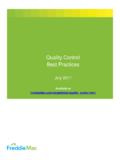Transcription of Procedures for obtaining informed consent for …
1 Procedures for obtaining informed consent for recordings and images of people to support Data Protection Policy Heriot-Watt Procedures for responding to requests for personal data; to support Data Protection Policy 1 HERIOT-WATT UNIVERSITY Procedures for obtaining informed consent for recordings and images of people CONTENTS Section Page 1 Introduction 2 2 Scope 2 3 Legal conditions for processing recordings of people 2 4 Photographs and recordings featuring students 3 5 Photographs and recordings featuring staff 4 6 General photography and filming 4 7 Photography and filming at University events 4 8 Photography or recordings of University groups 5 9 What to do if someone objects to the use of their image 6 10 recording lectures, meetings and interviews 6 11 Further help and advice 8 12 Definitions 8 13 Procedures version and history 9 Appendix A.
2 consent form for use of images, video and sound recordings containing personal data 10 Appendix B Photography/Filming notice 11 Appendix C Press/TV Photography/Filming notice 12 Heriot-Watt Procedures to support Data Protection Policy Version 2 March 2014 Author: Ann Jones URL 2 1. INTRODUCTION Still and moving images and sound recordings featuring identifiable individuals contain personal data of these individuals. As an organisation that creates and commissions images and recordings of people, the University is the Data Controller for this personal data. These Procedures set out the circumstances in which it is necessary to seek the consent of the individuals concerned and how to ensure that we manage recordings and images of people in. accordance with their rights as data subjects under the UK Data Protection Act, 1998 and the data protection laws of other relevant jurisdictions.
3 These Procedures support the Data Protection Policy and also other policies relating to the management of student and staff records, such as the Student Records Management Policy. These Procedures form part of the University Information Security Policy Framework. 2 SCOPE The scope of these Procedures applies to information that we hold about all current and former Heriot-Watt University students or staff, regardless of where or how they studied or worked. These Procedures apply to all still and moving images and recordings created or commissioned by University employees, contractors or volunteers in the course of their work for the University. The University is the Data Controller for all such images and recordings that feature people, regardless of where the recordings take place. The University determines the purpose of recording and is legally responsible and accountable for its use.
4 These Procedures do not apply to images or audio-visual recordings created by members of the University community or visitors for their own private use on their own personally owned equipment. The University is not the Data Controller for such recordings. However, personal use of images or audio-visual recordings to harass or cause distress to others may be subject to disciplinary sanctions in accordance with other University regulations and policies governing the conduct of students, colleagues and other users and may also be in breach of criminal law. 3. LEGAL CONDITIONS FOR PROCESSING RECORDINGS OF PEOPLE In order to process personal data lawfully, the University must comply with a relevant condition for processing. When processing still and moving images for promotional, journalistic and archival purposes the University will need to rely on one of the following conditions.
5 In some circumstances the University can rely on the condition that the processing is necessary for its legitimate interests as long as the processing is not unwarranted because of its prejudicial effect on the rights, freedoms or legitimate interests of the individual. Relevant examples include photography involving staff in senior or public facing roles, filming of graduation ceremonies a key event in the Heriot-Watt Procedures to support Data Protection Policy Version 2 March 2014 Author: Ann Jones URL 3 University calendar- as long as graduands and their families are informed in advance and chose to attend in the knowledge that the event is being filmed. filming or photography of other events or general views of the campus where the image or recording represents an unposed record of the event and any images of people are incidental then formal consent is not required as long as clearly visible notices are displayed to inform people that filming is taking place in that area so individuals can move out of the picture Where the University wishes to process images featuring students for promotional purposes a recruitment video or prospectus, the students are under no obligation to take part.
6 Therefore we have to rely on their consent to process their personal data in this way. consent must be freely given, specific and informed . It is important to keep a record of the individuals consent . It is also important to note that an individual may subsequently withdraw their consent to further processing of their image. Where the University invites newspaper or TV photographers or film crews to take still and moving images of news events for journalistic purposes, this is legitimate as long as the individuals involved in the event are fully informed in advance and given the opportunity to opt out of the picture, where appropriate 4 Photographs and recordings featuring students Where the University records or commissions photography or filming of particular students and those individuals are the focus of the pictures, consent must be obtained from the individual(s). An example would be an image of a small group of students chatting around a table in the Library or Cafe Brio.
7 The consent form they are asked to sign should state why the University is recording the images and what they will be used for, so that the individuals concerned can make an informed choice. A model consent form is provided in Appendix A. consent should be obtained from University students who feature in photographs or film in these circumstances, regardless of whether the images are being taken on University campus or elsewhere. The School, Institute or Professional Service commissioning the photography is responsible for ensuring that the University retains the signed agreement as an audit trail for the life of the image. To facilitate this, at the end of each project, a file containing the completed consent forms and copies of the images/recordings should be transferred to Media Services and Heritage and Information Governance for retention. Students under 18 years old The Age of Legal Capacity (Scotland) Act 1991 states that individuals aged 16 years and over in Scotland have capacity to enter into legal contracts.
8 There is therefore no reason why a student aged between 16 and 18 years old cannot Heriot-Watt Procedures to support Data Protection Policy Version 2 March 2014 Author: Ann Jones URL 4 consent or object in the same way as an 18 year old to their image being captured or used by the University. 5. Photographs and recordings featuring staff Colleagues in senior or public facing roles should have a reasonable expectation that their images will be used by the University in a variety of circumstances. In these situations the University is relying on its legitimate interests to use images of the members of staff. Managers are responsible for explaining this to colleagues within their teams, to help manage their expectations, and for making the public facing nature of the role clear in job descriptions at recruitment stage and in the contract of employment. Where colleagues are not in senior or public facing roles, they should be asked to consent to their images being recorded.
9 If a member of staff objects to their image being used in a particular way (for example being posted on a notice board), in such situations the University should remove or avoid using the relevant image. 6. General photography and filming Where colleagues take or commission photographs or filming for the University in which objects, buildings and areas are going to be the focus rather than particular people, students, staff and visitors should be given advance notice of this whenever possible by 1. Advertising it on the University's intranet and notice boards. The notice should publicise the date, time and place of the session, the purpose of the recording and details of the University contact in case of any queries or concerns. 2. Placing clearly visible notices around the area on the relevant day providing this information. People can then opt out of appearing incidentally in the recording and can avoid the area(s) if they wish to do so.
10 7. Photography and filming at University events Graduations Prior to graduation ceremonies, the organisers must inform graduands, guests and other attendees that still and moving images of the ceremony will be webcast live and captured on DVD, copies of which will be available immediately after the ceremony. Those in attendance at related events such as receptions must also be informed where the event is to be photographed or filmed. This information needs to be provided in the graduation packs and other literature issued to attendees in advance of the event. Contact details should be provided for anyone with concerns. If someone contacts the University with an objection to their image being captured at a graduation Heriot-Watt Procedures to support Data Protection Policy Version 2 March 2014 Author: Ann Jones URL 5 ceremony, the Information Commissioner s Office (ICO) guidance states that realistic alternative arrangements should be explored with that individual.
